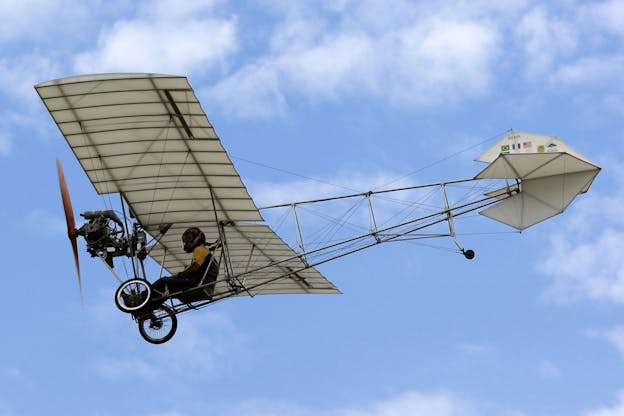Take To The Air With The Cartier Santos-Dumont Micro-Rotor Skeleton
A Cartier release from 2023 is an homage to one of the first airplanes ever made: the Santos-Dumont Demoiselle.
One of the oldest known wristwatch designs in the world is Cartier’s Santos-Dumont, which was, so the story goes, originally made for coffee magnate and aviation pioneer Alberto Santos-Dumont, in 1904. Santos-Dumont is credited as the inventor of the first practical airship – that is, a lighter-than-air craft with an engine capable of maneuvering independently of the wind, unlike a simple balloon – and he was also the inventor of the first internal combustion engine made specifically for aviation (a simple two cylinder design capable of 3.5 horsepower, but you gotta start somewhere).
He was also the inventor, in 1907, of what was at the time the most advanced airplane in the world: the “Demoiselle” as he called it, which was a surprisingly modern-looking design. The Demoiselle was a monoplane, with a single wing and an engine and propeller in the front, as opposed to the Wright Flyer, which was a pusher aircraft with elevators in the front, and which had to be launched from a track.

Santos-Dumont, so the story goes, was presented with the watch that would come to bear his name by Louis Cartier, in 1904. At the time, pocket watches were the standard and wristwatches such as they were, were just beginning to make inroads; “wristlet” watches were still considered something for ladies, although the use of pocket watches modified to be worn on the wrist had appeared during the Second Boer War, and they would be further legitimized by their widespread use in World War I – so much so that by 1916, the New York Times would write that “strap watches” had become obligatory for officers and soldiers. The Santos-Dumont watch, however, was not a modified pocket watch – it was designed from the ground up as a wristwatch, and it may be not only the first series produced wristwatch, but also the first pilot’s watch ever made.
In 2023, 119 years later, Cartier released the Cartier Sant0s-Dumont Micro-Rotor Skeleton. The Micro-Rotor Skeleton is an openworked version of the Santos-Dumont, 31mm square and 8mm thick. This is fairly close to the dimensions of the original Santos-Dumont, which was about 24.8 x 34.8 mm (a size which would strike many modern enthusiasts as unwearably small, though miniaturization in those days was a feature, not a bug, and a demonstration of a watchmaker’s mastery of the craft. The Santos-Dumont Micro-Rotor Skeleton is noticeably smaller than the medium sized Santos Automatic, which is 35.1 mm x 8.83 mm (although Cartier describes the Santos-Dumont Micro-Rotor Skeleton as a “large” model).

The movement is not an openworked version of a previous Cartier automatic caliber – caliber 9629 MC was developed specifically for this watch. The movement plate and bridges aren’t cut-outs from a pre-existing movement; instead, Cartier has developed a completely original movement architecture for the caliber, with a square bridge connecting the micro-rotor (in the shape of an airplane) the mainspring barrel on the upper right, and the balance on the upper left. The escape wheel is skeletonized as well, and inside the square is a long, gracefully arched bridge which contains some of the keyless works for winding and setting, as well as components of the automatic winding train.

The movement architecture is just as interesting from the back. Traditionally, openworking was revered by collectors because it involved taking an existing caliber, piercing the plates and bridges with a drill, and then cutting out as much metal as possible from the inside of the plates and bridges as you could, without compromising the structural integrity of the movement overall. However, Cartier’s approach allows the company – and this is something Cartier does extensively in its openworked movements – to create movements with much more flexibility in design; in this case, the visual effects including the micro-rotor, would have been challenging if not impossible with an existing caliber.

And here’s what closes the deal – the micro-rotor. It’s obviously in the shape of Alberto Santos-Dumont’s Demoiselle, right down to the optimistically wide wings and the hexagonal empennage. It is pointless of course from an engineering standpoint – the watch would have worked just fine with a standard micro-rotor, empennage be damned. But it is charming, and using technical fluency to create a visual and emotional effect that makes you forget all about technical watchmaking, is after all, what Cartier really does best.

One of the lovely things about Cartier’s classic designs, like the Tank, Santos, Baignoire and others, is that you can look down at your wrist and see essentially what Louis Cartier would have seen in the 1920s or 1930s. This is not exactly that. However, as a tribute to Alberto Santos-Dumont and the nearly 12 decade-old history of the design, the Santos-Dumont Micro-Rotor Skeleton is hard to beat. Now if only the official name from Cartier had been the Demoiselle, it’d be perfect.


